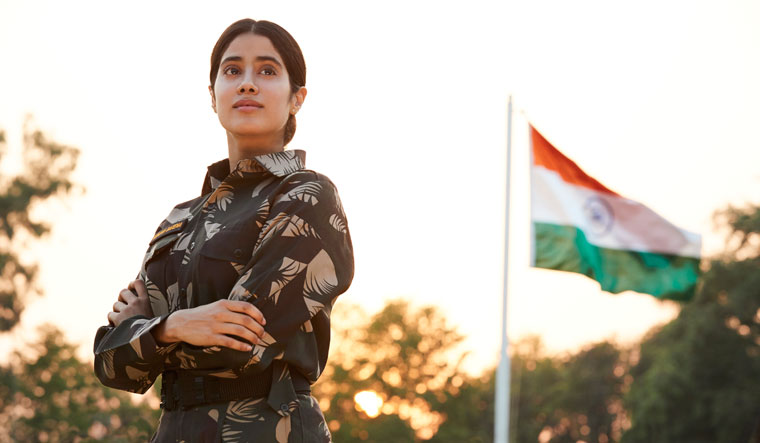In 1994, during an outbreak of bubonic and pneumonic plague in western and southern India, when the film Hum Aapke Hain Koun was all the rage among cinephiles, a teenager from Uttar Pradesh was nurturing an unlikely dream—to become a pilot. Gunjan Saxena could not remember having any other dream since childhood. Fortunately, her father, an army man, never clipped her wings. After graduating from Hansraj College in Delhi, she joined the Delhi Flying Club at Safdarjung, when the Indian Air Force had just started inducting women pilots into its ranks. “It was destiny,” says Saxena, 45, about her joining the Air Force in 1995. “One, because defence felt like a familiar environment, with my father being an army officer, and second, because no one can take away the glamour and glory of a defence uniform.”
The highlight of her Air Force career, which lasted till 2004, was her participation in the Kargil War in 1999. Saxena, the first woman pilot in the Indian Air Force, was 24 years old then and would be later awarded the Shaurya Chakra for her service. “Being part of the war helped me evolve, not just as an individual, but also as a professional and as an aviator,” says the “Kargil Girl”, as she later came to be known.
Her life has now inspired a movie, Gunjan Saxena: The Kargil Girl, starring Janhvi Kapoor in the lead. Debutant director Sharan Sharma recalls how, when he first telephoned Saxena, she dismissed it as a prank call. “Gunjan ma’am is very modest and she thinks her journey is very normal,” he says. “Forget the film, anyone who has heard her story has reacted strongly because it is such an inspiring one. I am very lucky that no one has picked it up in so many years.” He stumbled upon Saxena’s story in a small newspaper article. “The fact that she was 24 at the time of the Kargil War and [participated as] a rescue pilot appealed to me,” he says. “I got interested in how her brother was also in the army during the war and her father had been an army officer.”
Sharma, born and brought up in Mumbai, did not have much connect with the world of defence. As a first-time director, he was initially hesitant to explore such an unfamiliar terrain. But when he met Saxena, he discovered how the dynamics between her family members were so similar to his. It felt personal. Pankaj Tripathi plays Gunjan’s father Anuj. Tripathi’s character is such a pillar of support and strength to his daughter that many people thought it was “too filmy to be true”. Nevertheless, there was nothing false about it. “We may have taken cinematic liberty in retelling other things, but not the father-daughter relationship,” says Sharma.
Ultimately, the film is not just an inspirational tale about a female pilot. It subtly raises questions of everyday misogyny and sexism that still exist when it comes to letting women pursue their dreams. Kapoor’s restrained performance conveys the message without making it too in-your-face.
Contrary to the portrayal of Air Force pilots in the films Sharma had watched, he did not find Saxena to be too tough or aggressive when he met her in person. “The world never believed she could become an Air Force pilot,” says Sharma. “There is a lot of inner strength and confidence, but with a softened exterior and vulnerability. For us, it was important to find an unlikely hero—someone whom the world might doubt, but who could pull off the job and finish the task. That is the journey of the film as well. And Janhvi fit perfectly because she has that sense of vulnerability.”
“When you meet Gunjan ma’am, it is hard for you not to fall in love with her—her simplicity, warmth and all of her great achievements,” says Kapoor who, besides understanding Saxena’s personality and relationships, had to go through the rigorous process of gaining five kilos for the role and then losing them. “It was important for me to understand the life of a pilot, what it was like being inside a chopper, the on-field experience…. All of that was immensely helpful.”
“Janhvi and Sharan were really inquisitive, even after I often told them that so much was not required,” says Saxena, who was amazed at Kapoor’s desire to understand every aspect of her life during the training.
Even with its strong storyline, the film has been mired in controversy, especially on social media, ever since the release of its trailer. Some pointed out that the salute of the Indian Air Force has been depicted wrongly in the film. But it was correct in 1999, when the story takes place, says Sharma. “It was on March 7, 2006, that the salute changed and became a 45-degree salute,” he says. “I did not know this either. It was Gunjan ma’am who told me all of this, and I feel lucky to have had her by my side throughout the filming.” According to him, researching the film was an ongoing process because it is a huge responsibility to tell a story centred on the country and its defence forces.



